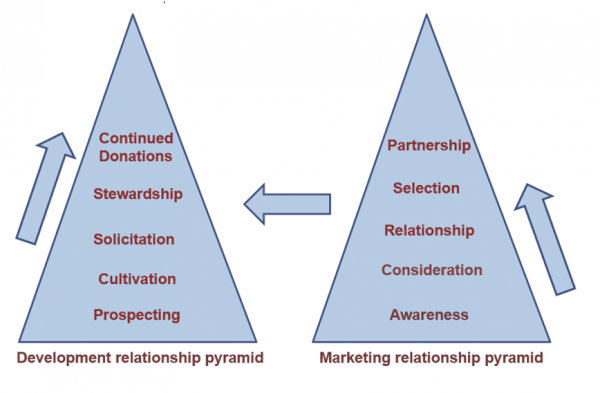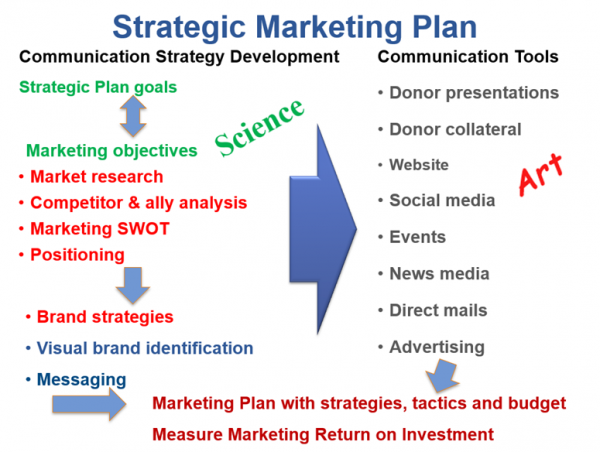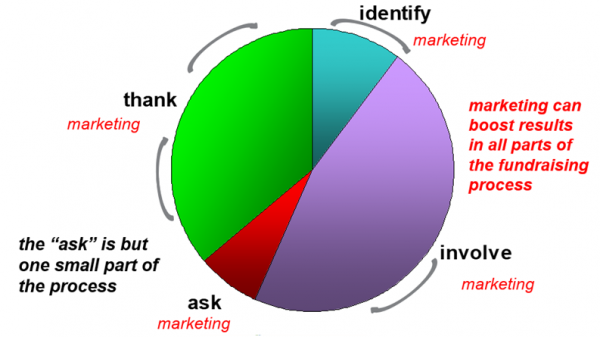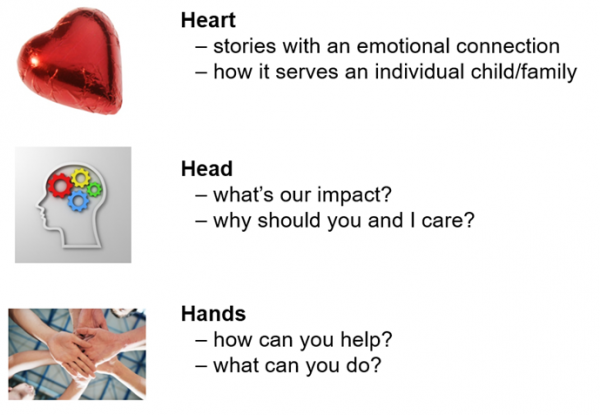Fundraising and Marketing are About Building Relationships
Fund development is about prospecting for potential donors, cultivating and seeking their support, stewarding contributions, thanking them properly, maintaining relationships and, hopefully, gaining continuing interest and funding (pictured below).
A parallel marketing relationship pyramid supports fundraising by building awareness among those who don’t know your cause; promotes consideration; helps develop a relationship and hopefully selection for funding, volunteering or other engagement. Then with continued engagement, hopefully they’ll become fans, partners, investors for years.
The need to build relationships is why content marketing – including social media and email campaigns – is so critical.
Why Plan for Marketing? Do more with less!
Benefits of a Marketing Plan
- Build your brand – your organization’s name and reputation are your most valuable marketing assets.
- Better Target – better identify and understand specific target markets.
- More Effectively Communicate – by ensuring that communications are focused, integrated, consistent and reinforced (check out online sources: everybody says do this to effectively communicate, but it’s tough to accomplish without a plan).
- Enable Prioritization – of actions to best utilize budget and time; you can think up more ways to communicate than you have time and funds to communicate. That’s great, because then you can choose what you think will be the most effective strategies and tactics to achieve your marketing objectives.
- Gain Engagement – of other staff and stakeholders; this is how you can get staff, board members, volunteers and outside freelancers/agencies aligned to pull in the same direction and multiply your results. Marshall an army of ambassadors to effectively communicate your cause!
- Measure Progress & Adapt – because your marketing objectives are measurable, you can assess progress and return on investment, as well as adapt as needed to achieve your objectives.
It’s not about who has the best tales, tools, and tactics
Rather than beginning with what we call “the Art part” of marketing – selecting media and firing away on communications, start with what we call “the Science side,” as in the image below. Start by building SMART marketing objectives (Specific, Measurable, Audience specific, Results oriented, and Time specific) in green.
Then proceed with some of the above research tools in bright red to form strategies to effectively position your nonprofit in the community, select target audiences and choose the most effective communication tools to develop campaigns.
Measurable support for fundraising will likely provide a couple of marketing objectives. What’s your target for total individual donations? What’s your “donor churn”, the number of individuals who gave a previous year, but not last year? As many businesses find it’s easier to maintain a customer than to find a new customer, the same is true for nonprofits; it’s often easier to maintain a donor’sinterestthan to find a new contributor. So, consider a marketing objective on renewals from past donors.
The resulting marketing plan includes all of the above sections with strategies and tactics designed to meet each of your marketing objectives along with a recommended budget and measures of return on investment.
As demonstrated in the diagram below, the fundraising “ask” is but a small part of the overall process. And you can use marketing strategies and tactics to strengthen each of the four steps in your fundraising process.
The #1 reason folks don’t give is – they’re not asked! The #1 reason people don’t give again is that they are not properly thanked. Sending a traditional income tax letter about no goods and services received is not enough. Multiple communications are needed: appreciation communications, updates on use of funds, your progress and impact.
Messaging and Storytelling
Nonprofit communications to stakeholders are all abouteffectively conveying the “Heart, Head, and Hands,”as diagramed below. Most nonprofits do well on communicating the “Heart” – those emotional pictures and stories of serving children, families, animals, causes. That’s a great start, but not sufficient. Many foundations, major donors, United Ways and governments also want to know why they should invest in you and why you’re a better investment than alternative nonprofits. That’s where the “Head” communication comes in – what’s your impact? Too often this is not well identified or highlighted enough. Finally, the “Hands” tell others specifically how they can help.
Some of these three dimensions are more important to specific funders than others, but effectively communicating all of them, tailored to your target audiences, will go far in truly reaching people. We’re individualizing mass communications, treating people as individuals and individual organizations with their own perceptions, viewpoints and community knowledge about your cause.
Nonprofit Messaging
Complete and Launch Your Marketing Plan
Key segments of plans that deliver superior results include:
- Marketing Research
- Content Marketing – social media and email campaigns
- Cutting-edge Strategic Planning
You may notice that what we call “the Science side” of a Marketing Plan parallels much of the “Strategic Thinking” included in an effective Strategic Plan.
So, your added bonus? Strategic4sight can help you efficiently accomplish your Marketing Plan and Strategic Plan at the same time.




